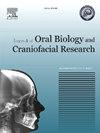用SEM-EDX对四种牙釉质再矿化剂再矿化电位的比较评价——一项体外研究。
Q1 Medicine
Journal of oral biology and craniofacial research
Pub Date : 2025-01-01
DOI:10.1016/j.jobcr.2025.01.006
引用次数: 0
摘要
目的:利用扫描电镜-能量色散x线比较四种牙釉质再矿化剂在人工脱矿牙釉质表面的再矿化电位。材料和方法:取出75颗上颌和下颌前磨牙,涂上耐酸指甲油,在脱矿液中保存96 h,形成人工龋齿。将样品分为5组(n = 15),对照组(脱矿-未处理)、第一组(酪蛋白-磷酸蛋白-无定形磷酸钙处理)、第二组(自组装肽处理)、第三组(三磷酸钙处理)和第四组(生物活性玻璃处理)。建立pH循环模型21 d。样品通过SEM-EDX(卡尔蔡司,德国;模型:梅林紧凑型)定性评估和定量分析钙和磷。采用IBM SPSS version 20对数据进行多组比较分析,采用单因素方差分析和配对t检验。结果:各试验组钙磷比;组1(1.92±0.17)、组2(1.98±0.16)、组3(1.81±0.03)、组4(1.75±0.08)差异有统计学意义(p)。尽管在I组和II组之间没有统计学上的显著差异,但在与表面分析相关后得出结论,II组显示出最大的再矿化潜力。本文章由计算机程序翻译,如有差异,请以英文原文为准。

Comparative evaluation of remineralizing potential of four enamel remineralising agents using SEM-EDX – An in-vitro study
Objective
Compare the remineralisation potential of four enamel remineralising agents on artificially demineralized enamel surface using Scanning electron microscopy- Energy dispersive x-ray.
Materials and methods
75 extracted maxillary and mandibular premolars coated with acid-resistant nail varnish, were stored in demineralising solution for 96 h to produce artificial caries lesions. The samples were divided into 5 groups (n = 15), Control (Demineralized- No treatment), Group I samples were treated with casein phosphoprotein-amorphous calcium phosphate (CPP-ACP), Group II with self-assembling peptide (SAP-14), Group III with tri-calcium phosphate (f-TCP) and Group IV with Bioactive glass (BAG), respectively. The pH cycling model was followed for 21 days. The samples were analysed via SEM-EDX (Carl Zeiss, Germany; Model: Merlin Compact) for qualitative assessment and quantitative analysis of calcium and phosphorous. The data were analysed for multiple group comparison using IBM SPSS version 20 with one-way ANOVA followed by a paired t-test.
Results
Calcium/Phosphorous ratio of all experimental groups; Group 1(1.92 ± .17), Group 2 (1.98 ± .16), Group 3 (1.81 ± .03), Group 4 (1.75 ± .08) was statistically different (p < 0.0005) from Control; while there was no difference between Group I and Group II (p = 0.33).
Conclusion
All experimental groups showed comparable remineralising potential. Even though no statistically significant difference is seen between Group I and Group II, after correlating with surface analysis it was concluded that Group II showed the greatest remineralising potential.
求助全文
通过发布文献求助,成功后即可免费获取论文全文。
去求助
来源期刊

Journal of oral biology and craniofacial research
Medicine-Otorhinolaryngology
CiteScore
4.90
自引率
0.00%
发文量
133
审稿时长
167 days
期刊介绍:
Journal of Oral Biology and Craniofacial Research (JOBCR)is the official journal of the Craniofacial Research Foundation (CRF). The journal aims to provide a common platform for both clinical and translational research and to promote interdisciplinary sciences in craniofacial region. JOBCR publishes content that includes diseases, injuries and defects in the head, neck, face, jaws and the hard and soft tissues of the mouth and jaws and face region; diagnosis and medical management of diseases specific to the orofacial tissues and of oral manifestations of systemic diseases; studies on identifying populations at risk of oral disease or in need of specific care, and comparing regional, environmental, social, and access similarities and differences in dental care between populations; diseases of the mouth and related structures like salivary glands, temporomandibular joints, facial muscles and perioral skin; biomedical engineering, tissue engineering and stem cells. The journal publishes reviews, commentaries, peer-reviewed original research articles, short communication, and case reports.
 求助内容:
求助内容: 应助结果提醒方式:
应助结果提醒方式:


